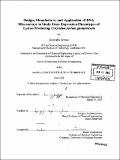| dc.contributor.advisor | Gregory Stephanopoulos. | en_US |
| dc.contributor.author | Roberge, Christopher (Christopher M.) | en_US |
| dc.contributor.other | Massachusetts Institute of Technology. Dept. of Chemical Engineering. | en_US |
| dc.date.accessioned | 2006-03-29T18:34:06Z | |
| dc.date.available | 2006-03-29T18:34:06Z | |
| dc.date.copyright | 2005 | en_US |
| dc.date.issued | 2005 | en_US |
| dc.identifier.uri | http://hdl.handle.net/1721.1/32322 | |
| dc.description | Thesis (Ph. D.)--Massachusetts Institute of Technology, Dept. of Chemical Engineering, 2005. | en_US |
| dc.description | Includes bibliographical references (leaves 197-213). | en_US |
| dc.description.abstract | Corynebacterium glutamicum partial genome DNA microarrays were constructed that were capable of assaying the transcriptional profile of the genes of pathways involved in central carbon metabolism and lysine biosynthesis. It was found that to ensure arrays of high quality, protocols applying the arrays should include DNase treatment of RNA samples. additional RNA filtration purification steps, and the use of gene specific primers in the formation of labeled cDNA through reverse transcription. After implementing these procedures, the accuracy and reproducibility of the array data were validated. The microarrays were used to explore the effects of the over-expression of the key anaplerotic enzyme pyruvate carboxylase and the use of different medium carbon source compositions, both of which have been shown to influence the yields of biomass on carbon and of lysine on biomass. Three different strains of C. glutamicum that were grown on six different minimal medium formulations that varied in their balance of glucose and lactate were assayed by isolating total mRNA samples from cultures in three different phases of growth and lysine production. Genes associated with glycolysis and the pentose phosphate pathway showed decreased transcript concentrations as the available carbon source was shifted from glucose to lactate, while those associated with the TCA cycle and the glyoxylate bypass demonstrated increased transcription. As the cultures stopped generating biomass and began generating lysine, mRNA of genes associated with lysine synthesis and export was measured at elevated concentrations. | en_US |
| dc.description.abstract | (cont.) Reduced gene expression trends seen for aspartokinase and aspartate semialdehyde dehydrogenase suggest that the enzymes are bottlenecks to lysine production, particularly when pyruvate carboxylase is over-expressed and lactate is the available carbon source. This over-expressing strain also had higher transcription levels of the genes of biotin synthesis. and lower transcription levels of the acyl-coA carboxylases dtsRl, dtsR2, accC, and accD. Other results implied that malic enzyme is co-expressed with pyruvate carboxylase to better allow cultures grown on lactate to produce NADPH in the absence of significant pentose phosphate pathway flux. Also, the transcriptional and flux profiles of a pair of C. glutamicum strains grown on two different medium compositions of isotopically labeled glucose and lactate were determined simultaneously from the same set of actively growing and lysine-producing cultures. Flux maps for each of the four combinations of strain and medium were constructed using calculations derived from metabolite balances and GC-MS measurements of the isotopic distributions within biomass hydrolysates of the pseudo-steady-state cultures. Comparisons of the two sets of data showed that 19 of 28 pairs of flux and transcription measurements had trends with good agreement with one another. Different pathways of the metabolic network were found to be controlled via transcription in varying degrees. On average, the Embden- Meyerhof-Parnas pathway was shown to be less likely to be regulated though transcription than the pathways of the tricarboxylic acid cycle and central carbon anaplerosis. | en_US |
| dc.description.abstract | (cont.) In the split pathway available to the cells for producing lysine, the succinylation branch showed an increase in flux for only the case of a pyruvate carboxylase over-expressing strain that was grown on lactate, while the alternate dehydrogenation branch showed a complementary decrease in flux. These flux changes were matched by changes in transcription that only occurred for the same culture and growth medium. Through these findings we have demonstrated the application of C. glutamicum DNA microarrays to the determination of how the cells regulate their responses at the transcriptional level to changes in both gene over-expression and medium composition. | en_US |
| dc.description.statementofresponsibility | by Christopher Roberge. | en_US |
| dc.format.extent | 220 leaves | en_US |
| dc.format.extent | 14267170 bytes | |
| dc.format.extent | 14281322 bytes | |
| dc.format.mimetype | application/pdf | |
| dc.format.mimetype | application/pdf | |
| dc.language.iso | eng | en_US |
| dc.publisher | Massachusetts Institute of Technology | en_US |
| dc.rights | M.I.T. theses are protected by copyright. They may be viewed from this source for any purpose, but reproduction or distribution in any format is prohibited without written permission. See provided URL for inquiries about permission. | en_US |
| dc.rights.uri | http://dspace.mit.edu/handle/1721.1/7582 | |
| dc.subject | Chemical Engineering. | en_US |
| dc.title | Design, manufacture, and application of DNA microarrays to study gene expression phenotypes of lysine-producing Corynebacterium glutamicum | en_US |
| dc.type | Thesis | en_US |
| dc.description.degree | Ph.D. | en_US |
| dc.contributor.department | Massachusetts Institute of Technology. Department of Chemical Engineering | |
| dc.identifier.oclc | 61368310 | en_US |
